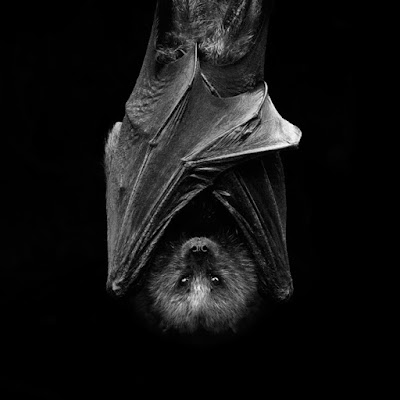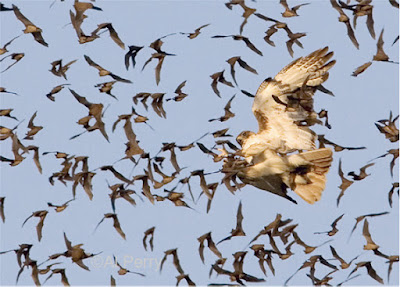Bats are the only mammals that can fly. At night, the bats would swoop in the air while grabbing hundreds of insects and other small animals. But during the day, bats hardly move at all, they would pass the time throughout the day by way of hanging upside down in a remote place like the roof of the cave, the underside of a bridge or inside a hollow tree.
 |
| Bat sleeps with hanging upside down. (Picture from: http://bit.ly/1TX1PvY) |
There are several different reasons why bats roost in a different way from other flying creatures.
1. Make it easier to start flying
First of all, by hanging upside down, will put them in an ideal position for takeoff when they will fly. Because unlike birds, bats can not fly directly into the air from the ground. Their wings can not generate enough power to lift them off.
 |
| Morphology of a Bat. (Picture from: http://bit.ly/1TX1PvY) |
In addition, their hind legs are also very small and not growing, so they can not run to achieve the required speed for takeoff. To overcome this, they will use their front claws to climb to a high enough. And then dropped to start their flights. With sleep hanging upside down in a high location, they will be ready to start flying at any time if they have to escape from their perches.
2. Avoiding predators and competition
By hanging upside down is also a good way for bats to avoid predators. During the day, when predators (especially birds of prey such as owls and hawks, etc) are most active, the bat will be in the most difficult to achieve by this predator. Thus allowing them safe from predators until nightfall.
 |
| These Brazilian free-tailed bats, are believed to have adopted a nocturnal way of life to avoid being eaten by day-time active predators. (Picture from: http://bit.ly/1MBEavc) |
In addition, very little competition for places perched upside down, as other flying animals do not have the ability to perch upside down like a bat.
3. Save energy when rested
Amazingly, the bat has a unique physiological adaptation that allows them hanging upside down without exerting any energy whatsoever. If you want clenching your hands to grasp an object, you have to contract the muscles in your arm some, which is connected to your fingers through the tendon. When a muscle contracts, the muscle will pull the tendon, and the tendon will pull the fingers on your hand to close.
 |
| Characteristics of a Bat. (Picture from: http://bit.ly/1PCRcIM) |
Bats claws also works in the same way, except that they are not connected to the tendons in the arm otor but connected in the upper body bat. To hang upside down, the bats just need to fly to a perch position he wanted, then opened his claws and found a surface that can be grasped. Weight of the upper body will pull the tendon that connects the claw downwards, and causes the claw clenching and gripping perch.
As a result, bats do not need to do anything else to hang upside down. They only needs to exert energy to release its grip, to stretch the muscles to pull the claws open. And because of the claws will continue closed when bats are resting, when the dead bats roost will continue hanging upside down until something (eg other bats) bumped into it and make it fall. *** [EKA | FROM VARIOUS SOURCES | ]
Note: This blog can be accessed via your smart phone.
